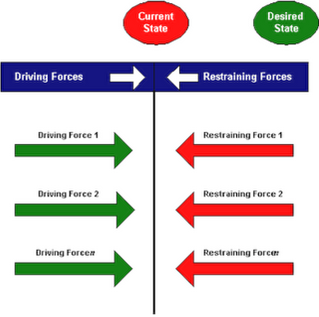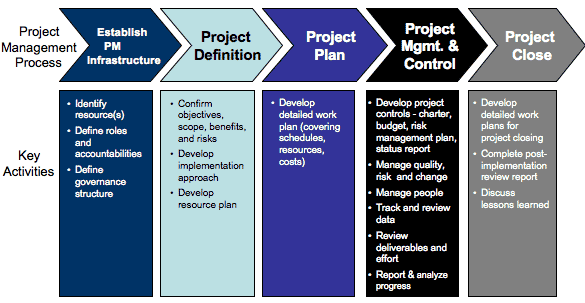
Once the Project Objectives are defined the next stage is Project Planning.
The effort which is put into the project planning stage will determine how smoothly and effectively the project runs and the better the chance of the Objectives being delivered on time.
The project manager normally uses a tool such as Microsoft Project Manager and the most common form of layout is the Gannt chart. Take a look at this for a detailed explanation:-
http://en.wikipedia.org/wiki/Gannt_Chart
The project is broken down into a Work Breakdown Structure which lists the main elements of the project. Each element is then broken down into a number of tasks and sub-tasks. Some of these are interdependent and need to be linked i.e one task cannot be started until the other is completed.
Any tasks which can be done in parallel to others are arranged as such and the idea is that the overall project timescale is minimized taking into account the resource available. This takes a lot of effort and it is likely that a number of iterations will be required. It is vital that each person responsible for a particular task is aware of the plan and has “bought in to it” i.e they agree with the timescales and with their responsibility to deliver a particular task. All of this relies on the PM’s negotiating skills. The plan should be reviewed by peers and management to ensure that it is as representative as possible. It should also have a sponsor who is a senior manager in the organization in case of any resource conflicts.
The overall length of the project is determined by the CRITICAL PATH – the tasks which have to follow on from each other from the start of the project to the end. If any one of these interdependent tasks takes longer than planned the project will overrun. If any can be shortened the overall project timescales may be shortened or another parallel task may then become part of the CRITICAL PATH. This will be easier understood by using a tool such as Microsoft Project and altering the duration of some of the key tasks on the critical path.
Some Common mistakes when constructing project plans:-
• In an effort to get the project moving not enough effort is put into planning – proper planning will save a lot of wasted effort later on.
• Resource is allocated without agreement of the nominee or their manager – people need to “buy in” to the project timescales.
• Under commercial pressure timescales are agreed which are not viable – the project manager needs to be resilient and highlight the risks, escalating to senior management if necessary.
• Tasks are poorly defined and ambiguous – they need to be broken down into manageable chunks and to be specific.
• The project progresses but the plan is not updated on a regular basis leading to unpleasant shocks when delays are highlighted – the project plan must be updated regularly (at least weekly) and published widely.
A well defined and structured project plan will identify resource and timescales enabling tasks to be completed on time and the project objectives delivered to expectations.
Best laid plans of mice and men aft gan agley – Robert Burns.
chris@projectsguru.co.uk
www.projectsguru.co.uk
 Friday’s News that Automotive component supplier Bosch is closing its plant in South Wales and moving manufacturing to Hungary was grim news for employees.
Friday’s News that Automotive component supplier Bosch is closing its plant in South Wales and moving manufacturing to Hungary was grim news for employees.
 Anyone involved in New Product Introduction (NPI) knows how critical time to market is but do they know how to quantify it?
Anyone involved in New Product Introduction (NPI) knows how critical time to market is but do they know how to quantify it? It is essential, when starting a project, that the team fully understands what the Objective is. This might sound obvious but is also something which is often overlooked. Sometimes the team is formed and the project kicked off without any clear statement about the Objective of the project. Consequently different Team members have different views on what the Objective is and this inevitably leads to unnecessary conflict and wasted effort.
It is essential, when starting a project, that the team fully understands what the Objective is. This might sound obvious but is also something which is often overlooked. Sometimes the team is formed and the project kicked off without any clear statement about the Objective of the project. Consequently different Team members have different views on what the Objective is and this inevitably leads to unnecessary conflict and wasted effort.
 Once the plan is in place & agreed the project then moves into the execution phase. This is when things really start happening and, if the planning has been done properly, things should proceed according to plan – right ?……Wrong !!
Once the plan is in place & agreed the project then moves into the execution phase. This is when things really start happening and, if the planning has been done properly, things should proceed according to plan – right ?……Wrong !! Ever noticed that, in teams, there are always arguments & some individuals always seem to disagree with everyone else ?
Ever noticed that, in teams, there are always arguments & some individuals always seem to disagree with everyone else ?

